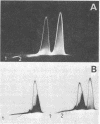Abstract
The methods of limited periodate oxidation and reductive amination were used to obtain covalently linked enterobacterial common antigen (ECA) with tetanus toxoid. This procedure is simple and gives a good yield of the conjugate with high ECA content (molecular ratio of ECA to tetanus toxoid, 6:1). The ECA-tetanus toxoid conjugate is immunogenic in rabbits, in contrast to free ECA or a mixture of ECA with proteins. This conjugate produces high levels of ECA-specific immunoglobulin G antibodies, which can be used as a standard serum.
Full text
PDF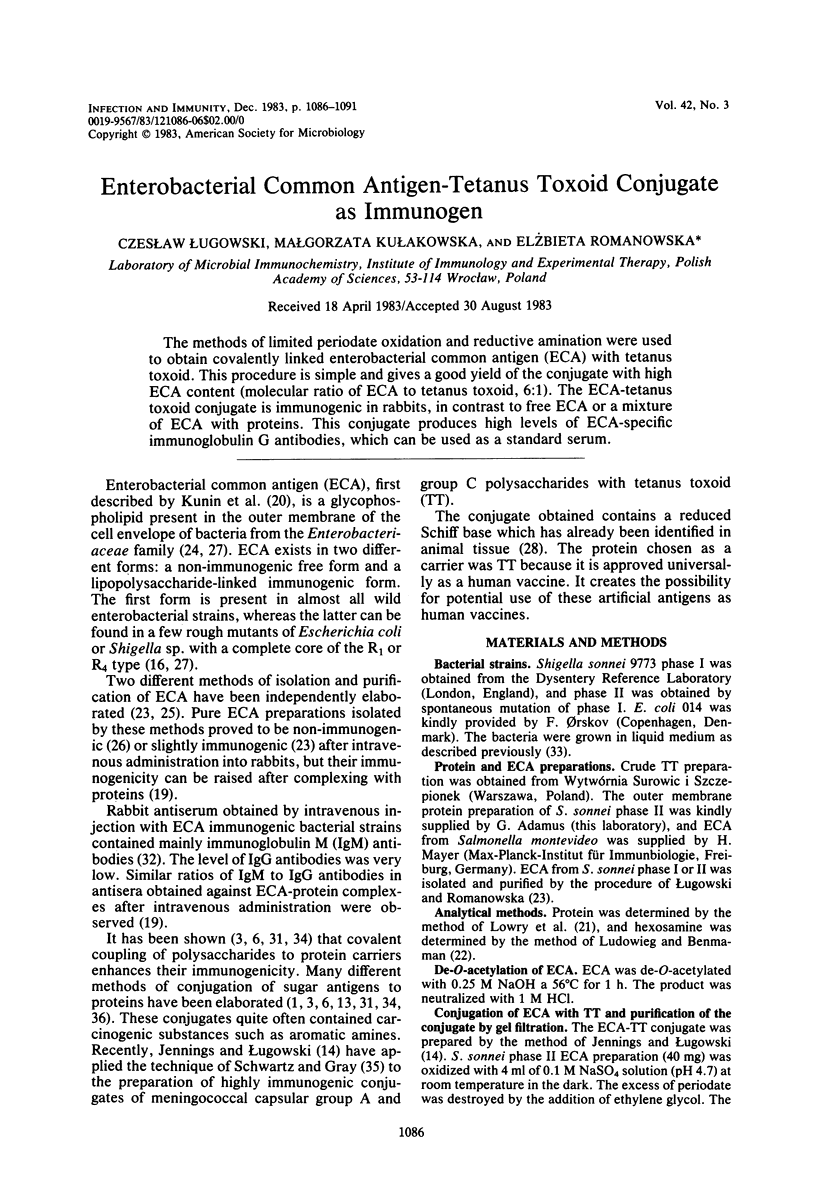
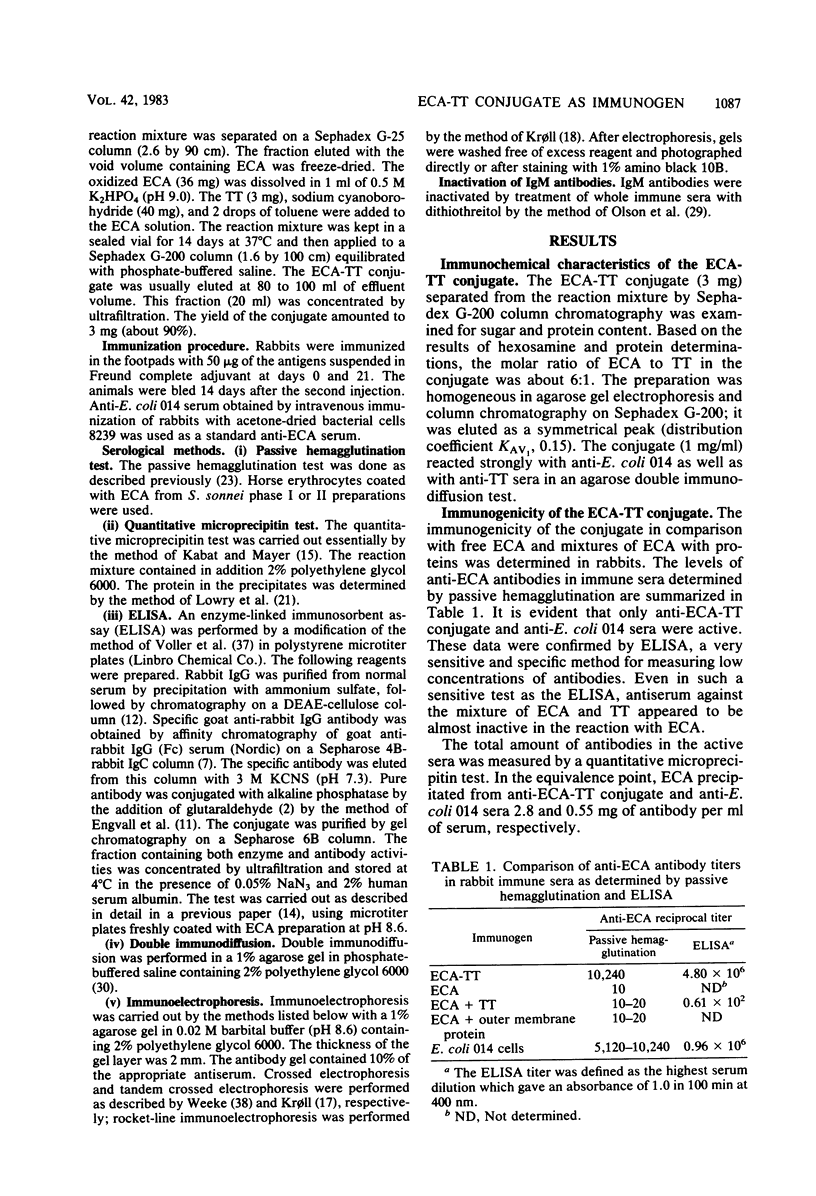
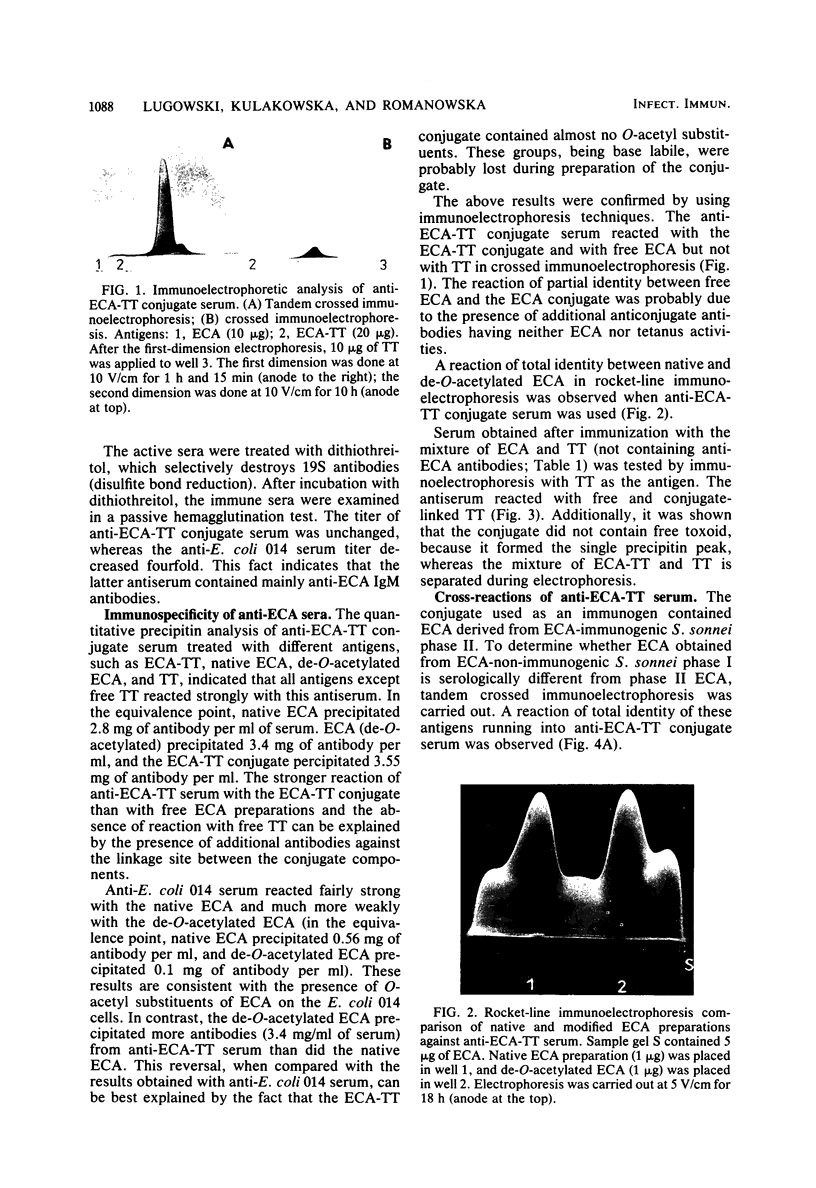
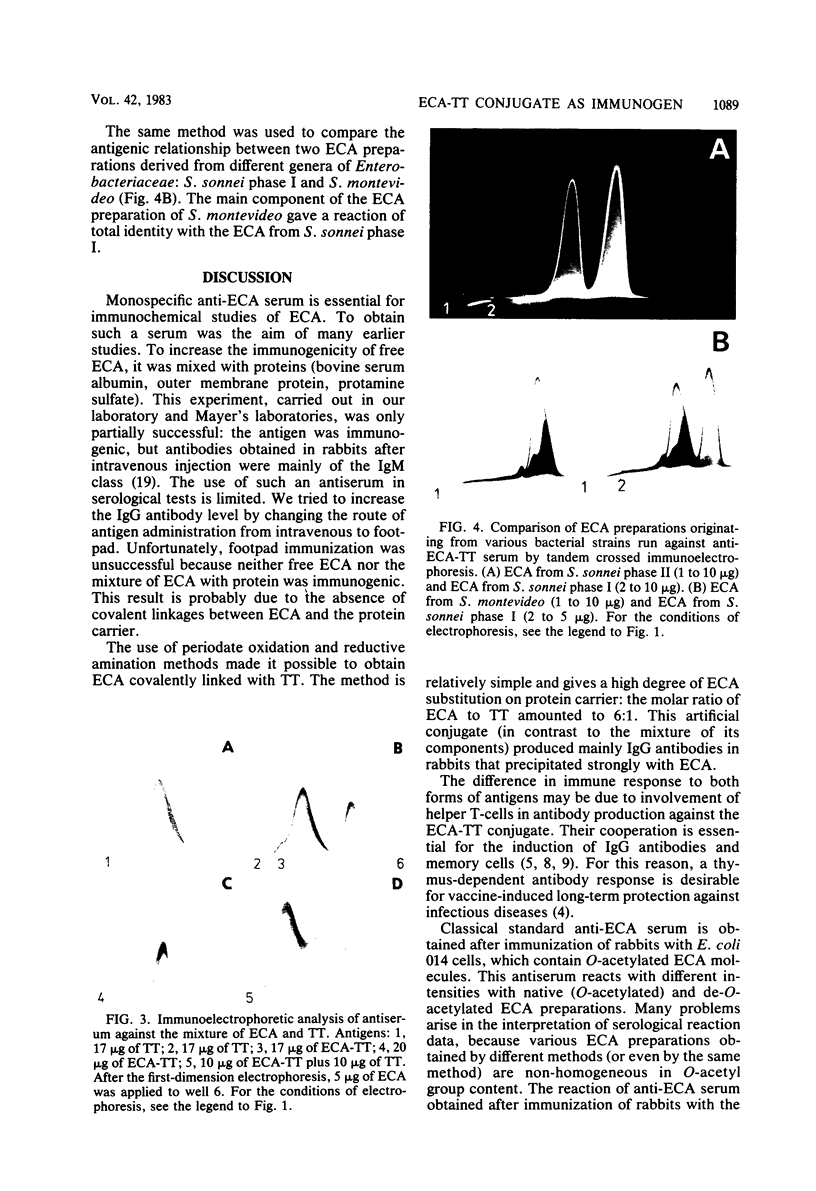
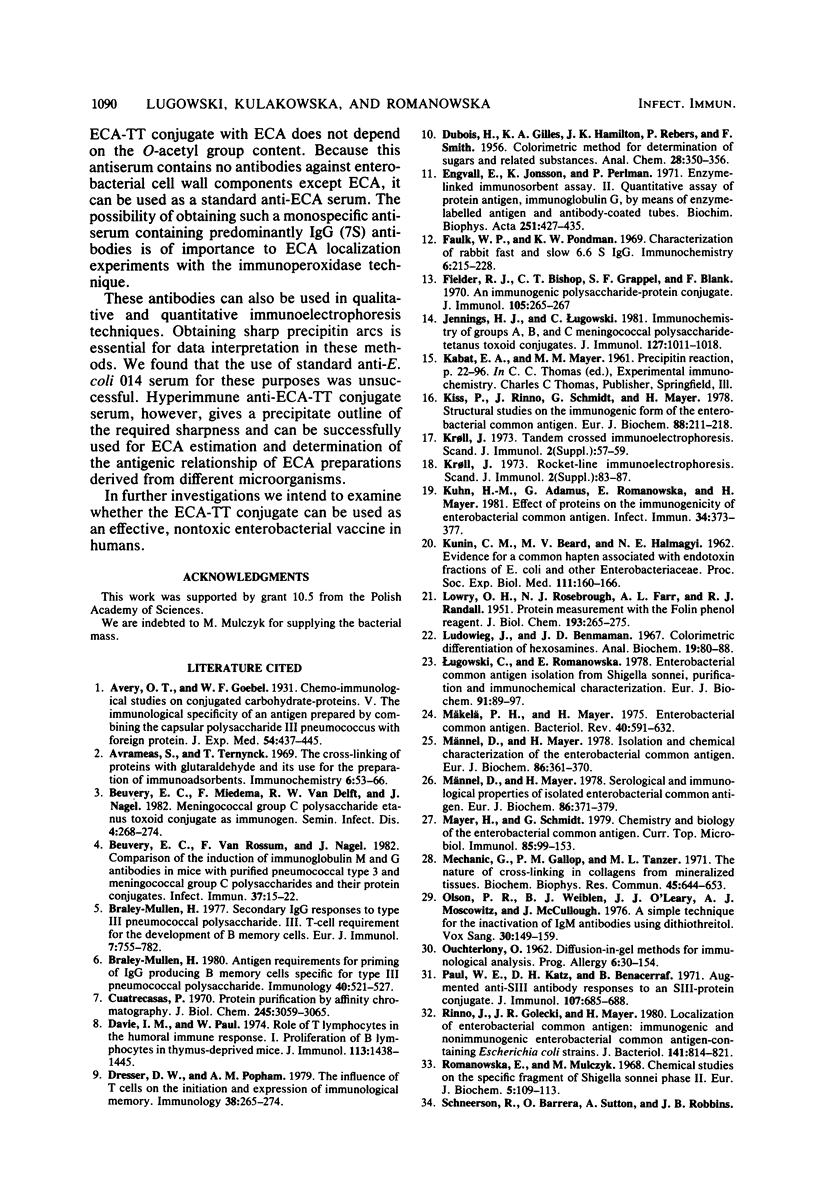
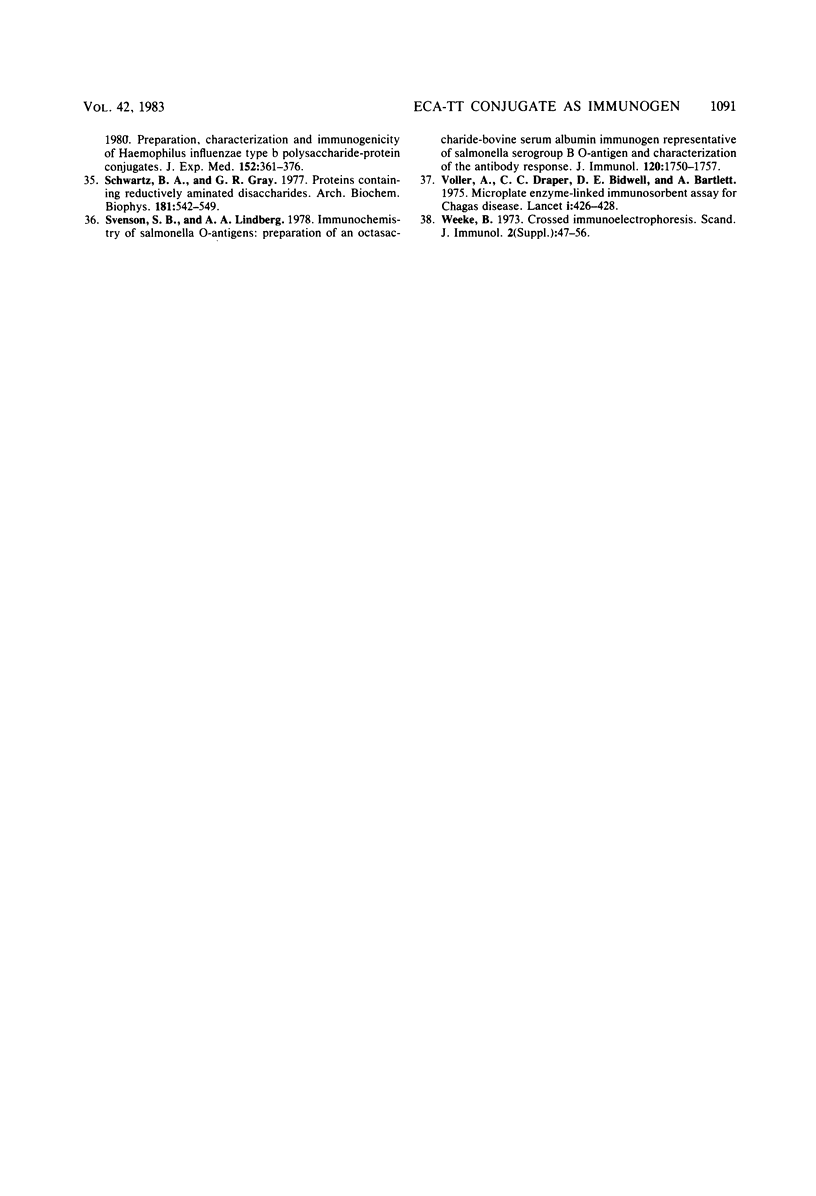
Images in this article
Selected References
These references are in PubMed. This may not be the complete list of references from this article.
- Avrameas S., Ternynck T. The cross-linking of proteins with glutaraldehyde and its use for the preparation of immunoadsorbents. Immunochemistry. 1969 Jan;6(1):53–66. doi: 10.1016/0019-2791(69)90178-5. [DOI] [PubMed] [Google Scholar]
- Beuvery E. C., van Rossum F., Nagel J. Comparison of the induction of immunoglobulin M and G antibodies in mice with purified pneumococcal type 3 and meningococcal group C polysaccharides and their protein conjugates. Infect Immun. 1982 Jul;37(1):15–22. doi: 10.1128/iai.37.1.15-22.1982. [DOI] [PMC free article] [PubMed] [Google Scholar]
- Braley-Mullen H. Antigen requirements for priming of IgG producing B memory cells specific for Type III pneumococcal polysaccharide. Immunology. 1980 Aug;40(4):521–527. [PMC free article] [PubMed] [Google Scholar]
- Cuatrecasas P. Protein purification by affinity chromatography. Derivatizations of agarose and polyacrylamide beads. J Biol Chem. 1970 Jun;245(12):3059–3065. [PubMed] [Google Scholar]
- Davie J. M., Paul W. E. Role of T lymphocytes in the humoral immune response. I. Proliferation of B lymphocytes in thymus-deprived mice. J Immunol. 1974 Nov;113(5):1438–1445. [PubMed] [Google Scholar]
- Dresser D. W., Popham A. M. The influence of T cells on the initiation and expression of immunological memory. Immunology. 1979 Oct;38(2):265–274. [PMC free article] [PubMed] [Google Scholar]
- Engvall E., Jonsson K., Perlmann P. Enzyme-linked immunosorbent assay. II. Quantitative assay of protein antigen, immunoglobulin G, by means of enzyme-labelled antigen and antibody-coated tubes. Biochim Biophys Acta. 1971 Dec 28;251(3):427–434. doi: 10.1016/0005-2795(71)90132-2. [DOI] [PubMed] [Google Scholar]
- Faulk W. P., Pondman K. W. Characterization of rabbit fast and slow 6-6S IgG. Immunochemistry. 1969 Mar;6(2):215–228. doi: 10.1016/0019-2791(69)90158-x. [DOI] [PubMed] [Google Scholar]
- Fielder R. J., Bishop C. T., Grappel S. F., Blank F. An immunogenic polysaccharide-protein conju- gate. J Immunol. 1970 Jul;105(1):265–267. [PubMed] [Google Scholar]
- Jennings H. J., Lugowski C. Immunochemistry of groups A, B, and C meningococcal polysaccharide-tetanus toxoid conjugates. J Immunol. 1981 Sep;127(3):1011–1018. [PubMed] [Google Scholar]
- Kiss P., Rinno J., Schmidt G., Mayer H. Structural studies on the immunogenic form of the enterobacterial common antigen. Eur J Biochem. 1978 Jul 17;88(1):211–218. doi: 10.1111/j.1432-1033.1978.tb12440.x. [DOI] [PubMed] [Google Scholar]
- Kuhn H. M., Adamus G., Romanowska E., Mayer H. Effect of proteins on the immunogenicity of enterobacterial common antigen. Infect Immun. 1981 Nov;34(2):373–377. doi: 10.1128/iai.34.2.373-377.1981. [DOI] [PMC free article] [PubMed] [Google Scholar]
- LOWRY O. H., ROSEBROUGH N. J., FARR A. L., RANDALL R. J. Protein measurement with the Folin phenol reagent. J Biol Chem. 1951 Nov;193(1):265–275. [PubMed] [Google Scholar]
- Ludowieg J., Benmaman J. D. Colorimetric differentiation of hexosamines. Anal Biochem. 1967 Apr;19(1):80–88. doi: 10.1016/0003-2697(67)90136-4. [DOI] [PubMed] [Google Scholar]
- Lugowski C., Romanowska E. Enterobacterial common antigen: isolation from Shigella sonnei, purification and immunochemical characterization. Eur J Biochem. 1978 Nov 2;91(1):89–97. doi: 10.1111/j.1432-1033.1978.tb20941.x. [DOI] [PubMed] [Google Scholar]
- Mayer H., Schmidt G. Chemistry and biology of the enterobacterial common antigen (ECA). Curr Top Microbiol Immunol. 1979;85:99–153. doi: 10.1007/978-3-642-67322-1_3. [DOI] [PubMed] [Google Scholar]
- Mechanic G., Gallop P. M., Tanzer M. L. The nature of crosslinking in collagens from mineralized tissues. Biochem Biophys Res Commun. 1971 Nov 5;45(3):644–653. doi: 10.1016/0006-291x(71)90465-7. [DOI] [PubMed] [Google Scholar]
- Mäkelä P. H., Mayer H. Enterobacterial common antigen. Bacteriol Rev. 1976 Sep;40(3):591–632. doi: 10.1128/br.40.3.591-632.1976. [DOI] [PMC free article] [PubMed] [Google Scholar]
- Männel D., Mayer H. Isolation and chemical characterization of the enterobacterial common antigen. Eur J Biochem. 1978 May 16;86(2):361–370. doi: 10.1111/j.1432-1033.1978.tb12318.x. [DOI] [PubMed] [Google Scholar]
- Männel D., Mayer H. Serological and immunological properties of isolated enterobacterial common antigen. Eur J Biochem. 1978 May 16;86(2):371–379. doi: 10.1111/j.1432-1033.1978.tb12319.x. [DOI] [PubMed] [Google Scholar]
- OUCHTERLONY O. Diffusion-in-gel methods for immunological analysis. II. Prog Allergy. 1962;6:30–154. doi: 10.1159/000313795. [DOI] [PubMed] [Google Scholar]
- Olson P. R., Weiblen B. J., O'Leary J. J., Moscowitz A. J., McCullough J. A simple technique for the inactivation of IgM antibodies using dithiothreitol. Vox Sang. 1976;30(2):149–159. doi: 10.1111/j.1423-0410.1976.tb02806.x. [DOI] [PubMed] [Google Scholar]
- Paul W. E., Katz D. H., Benacerraf B. Augmented anti-S 3 antibody responses to an S 3 -protein conjugate. J Immunol. 1971 Sep;107(3):685–688. [PubMed] [Google Scholar]
- Rinno J., Golecki J. R., Mayer H. Localization of enterobacterial common antigen:immunogenic and nonimmunogenic enterobacterial common antigen-containing Escherichia coli. J Bacteriol. 1980 Feb;141(2):814–821. doi: 10.1128/jb.141.2.814-821.1980. [DOI] [PMC free article] [PubMed] [Google Scholar]
- Romanowska E., Mulczyk M. Chemical studies on the specific fragment of Shigella sonnei phase II. Eur J Biochem. 1968 Jun;5(1):109–113. doi: 10.1111/j.1432-1033.1968.tb00343.x. [DOI] [PubMed] [Google Scholar]
- Schwartz B. A., Gray G. R. Proteins containing reductively aminated disaccharides. Synthesis and chemical characterization. Arch Biochem Biophys. 1977 Jun;181(2):542–549. doi: 10.1016/0003-9861(77)90261-2. [DOI] [PubMed] [Google Scholar]
- Svenson S. B., Lindberg A. A. Immunochemistry of Salmonella O-antigens: preparation of an octasaccharide-bovine serum albumin immunogen representative of Salmonella serogroup B O-antigen and characterization of the antibody response. J Immunol. 1978 May;120(5):1750–1757. [PubMed] [Google Scholar]
- Voller A., Draper C., Bidwell D. E., Bartlett A. Microplate enzyme-linked immunosorbent assay for chagas' disease. Lancet. 1975 Feb 22;1(7904):426–428. doi: 10.1016/s0140-6736(75)91492-0. [DOI] [PubMed] [Google Scholar]
- Weeke B. Crossed immunoelectrophoresis. Scand J Immunol Suppl. 1973;1:47–56. doi: 10.1111/j.1365-3083.1973.tb03778.x. [DOI] [PubMed] [Google Scholar]





